Yiquan Wang
Crypto-ncRNA: Non-coding RNA (ncRNA) Based Encryption Algorithm
Apr 24, 2025Abstract:In the looming post-quantum era, traditional cryptographic systems are increasingly vulnerable to quantum computing attacks that can compromise their mathematical foundations. To address this critical challenge, we propose crypto-ncRNA-a bio-convergent cryptographic framework that leverages the dynamic folding properties of non-coding RNA (ncRNA) to generate high-entropy, quantum-resistant keys and produce unpredictable ciphertexts. The framework employs a novel, multi-stage process: encoding plaintext into RNA sequences, predicting and manipulating RNA secondary structures using advanced algorithms, and deriving cryptographic keys through the intrinsic physical unclonability of RNA molecules. Experimental evaluations indicate that, although crypto-ncRNA's encryption speed is marginally lower than that of AES, it significantly outperforms RSA in terms of efficiency and scalability while achieving a 100% pass rate on the NIST SP 800-22 randomness tests. These results demonstrate that crypto-ncRNA offers a promising and robust approach for securing digital infrastructures against the evolving threats posed by quantum computing.
STGCN-LSTM for Olympic Medal Prediction: Dynamic Power Modeling and Causal Policy Optimization
Jan 29, 2025Abstract:This paper proposes a novel hybrid model, STGCN-LSTM, to forecast Olympic medal distributions by integrating the spatio-temporal relationships among countries and the long-term dependencies of national performance. The Spatial-Temporal Graph Convolution Network (STGCN) captures geographic and interactive factors-such as coaching exchange and socio-economic links-while the Long Short-Term Memory (LSTM) module models historical trends in medal counts, economic data, and demographics. To address zero-inflated outputs (i.e., the disparity between countries that consistently yield wins and those never having won medals), a Zero-Inflated Compound Poisson (ZICP) framework is incorporated to separate random zeros from structural zeros, providing a clearer view of potential breakthrough performances. Validation includes historical backtracking, policy shock simulations, and causal inference checks, confirming the robustness of the proposed method. Results shed light on the influence of coaching mobility, event specialization, and strategic investment on medal forecasts, offering a data-driven foundation for optimizing sports policies and resource allocation in diverse Olympic contexts.
Fractal and Turbulent Feature Extraction and NFT Label Generation for Pollock Style Migration Paintings Based on VGG19
Oct 29, 2024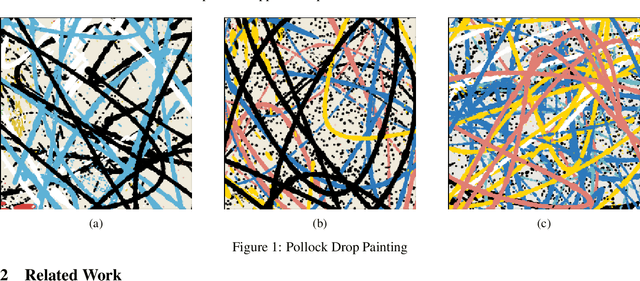
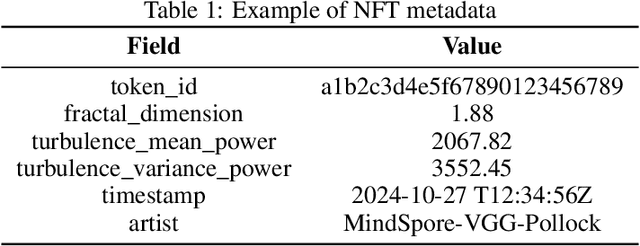
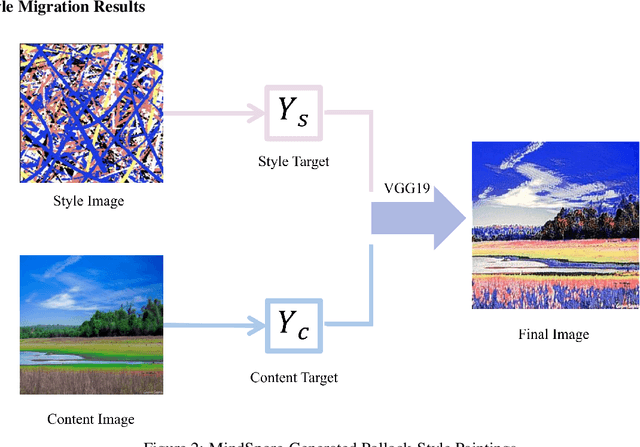
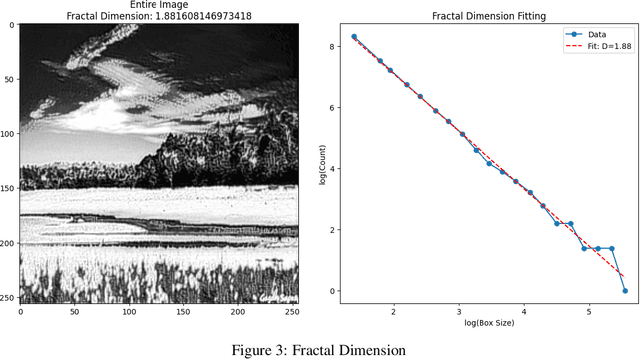
Abstract:This paper puts forth an innovative approach that fuses deep learning, fractal analysis, and turbulence feature extraction techniques to create abstract artworks in the style of Pollock. The content and style characteristics of the image are extracted by the MindSpore deep learning framework and a pre-trained VGG19 model. An optimisation process is then employed to The method generates high-quality Pollock-style images by combining content loss, style loss and full variance loss to achieve accurate style migration. Furthermore, this paper implements a fractal dimension calculation method based on the difference box-counting method, which effectively estimates the fractal dimension of an image through edge extraction and fractal analysis. The method is based on a two-dimensional discrete wavelet transform using a Haar wavelet to decompose the image in order to extract different frequency information. This is followed by the combination of multiple features to generate unique non-homogeneous token (NFT) labels for the authentication and protection of digital artwork. The experimental results demonstrate that the generated artworks exhibit The method demonstrates significant diversity and complexity in terms of fractal dimensions and turbulence features, while the generated NFT tags ensure the uniqueness and tamperability of each digital collection. The present method organically combines computer vision, digital signal processing and blockchain technology to provide a new solution for the creation and authentication of digital artworks.
Research on Travel Route Planing Problems Based on Greedy Algorithm
Oct 17, 2024Abstract:The greedy algorithm based route planning problem is a method of finding the optimal or near optimal route between a given starting and ending point. This article first uses PCA method to reduce the dimensionality of urban evaluation indicators, extracts key principal components, and KMO and TOPSIS algorithms to reduce the dimensionality of the data. Secondly, for datasets that have not passed the KMO test, a comprehensive evaluation will be conducted using the entropy weight method and TOPSIS method. Finally, based on the greedy algorithm, a route planning algorithm was proposed and optimized to provide personalized route customization according to the different needs of tourists. We also took into account the local travel efficiency, the time required to visit tourist attractions, and necessary daily rest time to reduce costs and avoid falling into the local optimal solution.
Octopus Inspired Optimization Algorithm: Multi-Level Structures and Parallel Computing Strategies
Oct 10, 2024



Abstract:This paper introduces a novel bionic intelligent optimisation algorithm, Octopus Inspired Optimization (OIO) algorithm, which is inspired by the neural structure of octopus, especially its hierarchical and decentralised interaction properties. By simulating the sensory, decision-making, and executive abilities of octopuses, the OIO algorithm adopts a multi-level hierarchical strategy, including tentacles, suckers, individuals and groups, to achieve an effective combination of global and local search. This hierarchical design not only enhances the flexibility and efficiency of the algorithm, but also significantly improves its search efficiency and adaptability. In performance evaluations, including comparisons with existing mainstream intelligent optimisation algorithms, OIO shows faster convergence and higher accuracy, especially when dealing with multimodal functions and high-dimensional optimisation problems. This advantage is even more pronounced as the required minimum accuracy is higher, with the OIO algorithm showing an average speedup of 2.27 times that of conventional particle swarm optimisation (PSO) and 9.63 times that of differential evolution (DE) on multimodal functions. In particular, when dealing with high-dimensional optimisation problems, OIO achieves an average speed of 10.39 times that of DE, demonstrating its superior computational efficiency. In addition, the OIO algorithm also shows a reduction of about $5\%$ in CPU usage efficiency compared to PSO, which is reflected in the efficiency of CPU resource usage also shows its efficiency. These features make the OIO algorithm show great potential in complex optimisation problems, and it is especially suitable for application scenarios that require fast, efficient and robust optimisation methods, such as robot path planning, supply chain management optimisation, and energy system management.
If LLM Is the Wizard, Then Code Is the Wand: A Survey on How Code Empowers Large Language Models to Serve as Intelligent Agents
Jan 08, 2024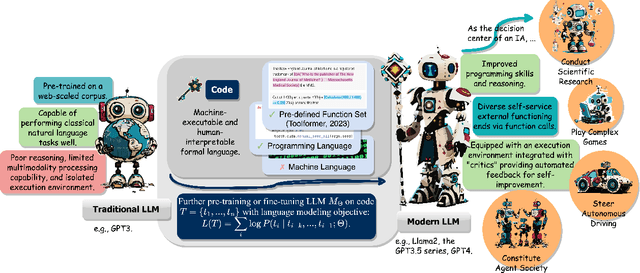

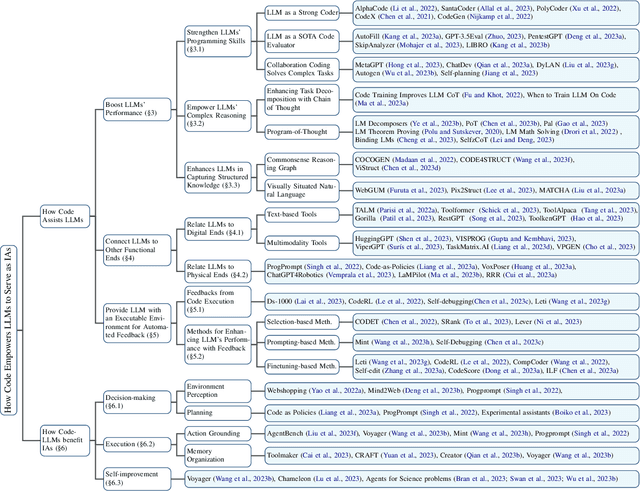
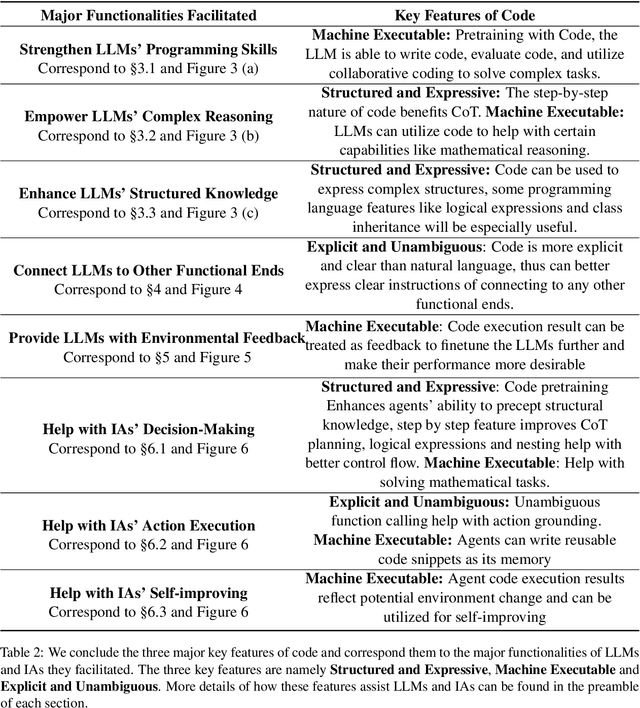
Abstract:The prominent large language models (LLMs) of today differ from past language models not only in size, but also in the fact that they are trained on a combination of natural language and formal language (code). As a medium between humans and computers, code translates high-level goals into executable steps, featuring standard syntax, logical consistency, abstraction, and modularity. In this survey, we present an overview of the various benefits of integrating code into LLMs' training data. Specifically, beyond enhancing LLMs in code generation, we observe that these unique properties of code help (i) unlock the reasoning ability of LLMs, enabling their applications to a range of more complex natural language tasks; (ii) steer LLMs to produce structured and precise intermediate steps, which can then be connected to external execution ends through function calls; and (iii) take advantage of code compilation and execution environment, which also provides diverse feedback for model improvement. In addition, we trace how these profound capabilities of LLMs, brought by code, have led to their emergence as intelligent agents (IAs) in situations where the ability to understand instructions, decompose goals, plan and execute actions, and refine from feedback are crucial to their success on downstream tasks. Finally, we present several key challenges and future directions of empowering LLMs with code.
 Add to Chrome
Add to Chrome Add to Firefox
Add to Firefox Add to Edge
Add to Edge